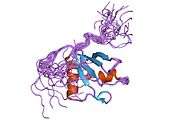MATR3
Matrin-3 is a protein that in humans is encoded by the MATR3 gene.[4][5]
Function
The protein encoded by this gene is localized in the nuclear matrix. It may play a role in transcription or may interact with other nuclear matrix proteins to form the internal fibrogranular network. Two transcript variants encoding the same protein have been identified for this gene.[5]
Pathology
Mutations in the Matrin 3 gene are associated with familial amyotrophic lateral sclerosis.[6]
References
- 1 2 3 GRCm38: Ensembl release 89: ENSMUSG00000037236 - Ensembl, May 2017
- ↑ "Human PubMed Reference:".
- ↑ "Mouse PubMed Reference:".
- ↑ Belgrader P, Dey R, Berezney R (Jun 1991). "Molecular cloning of matrin 3. A 125-kilodalton protein of the nuclear matrix contains an extensive acidic domain". J Biol Chem. 266 (15): 9893–9. PMID 2033075.
- 1 2 "Entrez Gene: MATR3 matrin 3".
- ↑ Johnson JO, Pioro EP, Boehringer A, Chia R, Feit H, Renton AE, Pliner HA, Abramzon Y, Marangi G, Winborn BJ, Gibbs JR, Nalls MA, Morgan S, Shoai M, Hardy J, Pittman A, Orrell RW, Malaspina A, Sidle KC, Fratta P, Harms MB, Baloh RH, Pestronk A, Weihl CC, Rogaeva E, Zinman L, Drory VE, Borghero G, Mora G, Calvo A, Rothstein JD, Drepper C, Sendtner M, Singleton AB, Taylor JP, Cookson MR, Restagno G, Sabatelli M, Bowser R, Chiò A, Traynor BJ (2014). "Mutations in the Matrin 3 gene cause familial amyotrophic lateral sclerosis". Nat. Neurosci. 17 (5): 664–6. doi:10.1038/nn.3688. PMC 4000579. PMID 24686783.
Further reading
- Stuurman N; Meijne AM; van der Pol AJ; et al. (1990). "The nuclear matrix from cells of different origin. Evidence for a common set of matrix proteins". J. Biol. Chem. 265 (10): 5460–5. PMID 2180926.
- Andersson B; Wentland MA; Ricafrente JY; et al. (1996). "A "double adaptor" method for improved shotgun library construction". Anal. Biochem. 236 (1): 107–13. doi:10.1006/abio.1996.0138. PMID 8619474.
- Yu W; Andersson B; Worley KC; et al. (1997). "Large-scale concatenation cDNA sequencing". Genome Res. 7 (4): 353–8. doi:10.1101/gr.7.4.353. PMC 139146. PMID 9110174.
- Okumara K; Nogami M; Matsushima Y; et al. (1998). "Mapping of human DNA-binding nuclear protein (NP220) to chromosome band 2p13.1-p13.2 and its relation to matrin 3". Biosci. Biotechnol. Biochem. 62 (8): 1640–2. doi:10.1271/bbb.62.1640. PMID 9757574.
- Nagase T; Ishikawa K; Suyama M; et al. (1999). "Prediction of the coding sequences of unidentified human genes. XI. The complete sequences of 100 new cDNA clones from brain which code for large proteins in vitro". DNA Res. 5 (5): 277–86. doi:10.1093/dnares/5.5.277. PMID 9872452.
- Hu RM; Han ZG; Song HD; et al. (2000). "Gene expression profiling in the human hypothalamus-pituitary-adrenal axis and full-length cDNA cloning". Proc. Natl. Acad. Sci. U.S.A. 97 (17): 9543–8. doi:10.1073/pnas.160270997. PMC 16901. PMID 10931946.
- Zhang Z, Carmichael GG (2001). "The fate of dsRNA in the nucleus: a p54(nrb)-containing complex mediates the nuclear retention of promiscuously A-to-I edited RNAs". Cell. 106 (4): 465–75. doi:10.1016/S0092-8674(01)00466-4. PMID 11525732.
- Bernert G, Fountoulakis M, Lubec G (2003). "Manifold decreased protein levels of matrin 3, reduced motor protein HMP and hlark in fetal Down's syndrome brain". Proteomics. 2 (12): 1752–7. doi:10.1002/1615-9861(200212)2:12<1752::AID-PROT1752>3.0.CO;2-Y. PMID 12469345.
- Strausberg RL; Feingold EA; Grouse LH; et al. (2003). "Generation and initial analysis of more than 15,000 full-length human and mouse cDNA sequences". Proc. Natl. Acad. Sci. U.S.A. 99 (26): 16899–903. doi:10.1073/pnas.242603899. PMC 139241. PMID 12477932.
- Zhang C; Dowd DR; Staal A; et al. (2003). "Nuclear coactivator-62 kDa/Ski-interacting protein is a nuclear matrix-associated coactivator that may couple vitamin D receptor-mediated transcription and RNA splicing". J. Biol. Chem. 278 (37): 35325–36. doi:10.1074/jbc.M305191200. PMID 12840015.
- Leonard D, Ajuh P, Lamond AI, Legerski RJ (2003). "hLodestar/HuF2 interacts with CDC5L and is involved in pre-mRNA splicing". Biochem. Biophys. Res. Commun. 308 (4): 793–801. doi:10.1016/S0006-291X(03)01486-4. PMID 12927788.
- Ota T; Suzuki Y; Nishikawa T; et al. (2004). "Complete sequencing and characterization of 21,243 full-length human cDNAs". Nat. Genet. 36 (1): 40–5. doi:10.1038/ng1285. PMID 14702039.
- Beausoleil SA; Jedrychowski M; Schwartz D; et al. (2004). "Large-scale characterization of HeLa cell nuclear phosphoproteins". Proc. Natl. Acad. Sci. U.S.A. 101 (33): 12130–5. doi:10.1073/pnas.0404720101. PMC 514446. PMID 15302935.
- Gerhard DS; Wagner L; Feingold EA; et al. (2004). "The status, quality, and expansion of the NIH full-length cDNA project: the Mammalian Gene Collection (MGC)". Genome Res. 14 (10B): 2121–7. doi:10.1101/gr.2596504. PMC 528928. PMID 15489334.
- Rual JF; Venkatesan K; Hao T; et al. (2005). "Towards a proteome-scale map of the human protein-protein interaction network". Nature. 437 (7062): 1173–8. doi:10.1038/nature04209. PMID 16189514.
- Lim J; Hao T; Shaw C; et al. (2006). "A protein-protein interaction network for human inherited ataxias and disorders of Purkinje cell degeneration". Cell. 125 (4): 801–14. doi:10.1016/j.cell.2006.03.032. PMID 16713569.
- Olsen JV; Blagoev B; Gnad F; et al. (2006). "Global, in vivo, and site-specific phosphorylation dynamics in signaling networks". Cell. 127 (3): 635–48. doi:10.1016/j.cell.2006.09.026. PMID 17081983.
- Ewing RM; Chu P; Elisma F; et al. (2007). "Large-scale mapping of human protein-protein interactions by mass spectrometry". Mol. Syst. Biol. 3 (1): 89. doi:10.1038/msb4100134. PMC 1847948. PMID 17353931.
- Valencia CA, Ju W, Liu R (2007). "Matrin 3 is a Ca2+/calmodulin-binding protein cleaved by caspases". Biochem. Biophys. Res. Commun. 361 (2): 281–6. doi:10.1016/j.bbrc.2007.06.156. PMID 17658460.
This article is issued from
Wikipedia.
The text is licensed under Creative Commons - Attribution - Sharealike.
Additional terms may apply for the media files.




